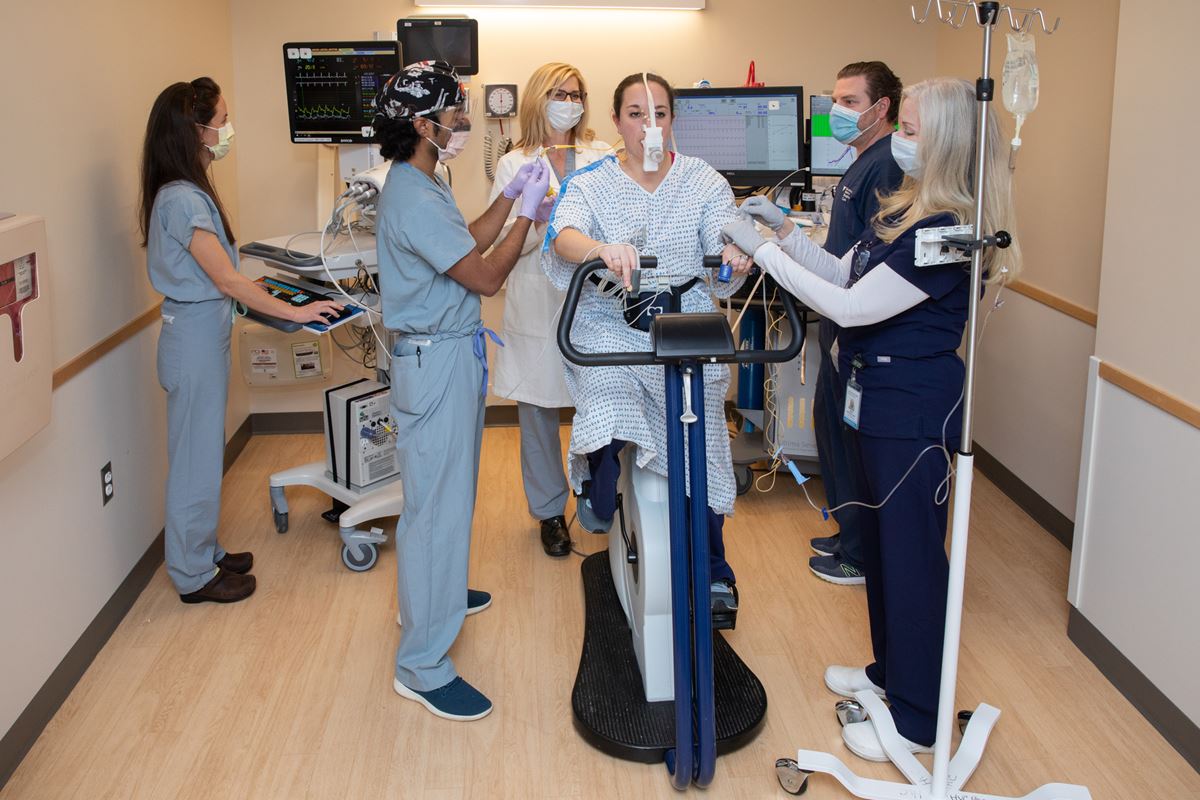
Popular Locations
- Yale New Haven Children's Hospital
- Yale New Haven Hospital - York Street Campus
- Yale New Haven Hospital - Saint Raphael Campus

With multiple locations, Yale New Haven Hospital’s Pulmonary Function Labs perform a full spectrum of Pulmonary Function Tests (PFT) to identify and evaluate how well the lungs are working. The PFTs are primarily noninvasive tests that measure lung volume, capacity, rate of flow and gas exchange. This information can help your healthcare provider diagnose and decide the best treatment for certain lung disorders. The purpose, procedure, discomfort and risks of each test will vary.
As part of the Winchester Center for Lung Disease, the Pulmonary Function Labs cover a range of tests including:
Arterial Blood Gas tests directly measure the levels of gases, such as oxygen and carbon dioxide in your blood. For this test, blood is taken from an artery, usually in the wrist where your pulse is measured. You may feel brief pain when the needle is inserted or when a tube attached to the needle fills with blood. This test can also be performed after breathing 100% oxygen, which is called a Shunt Study.
Cardiopulmonary Exercise Test (CPET) is a maximal stress test that looks at your breathing, gas exchange and heart rhythm at the same time. The test is commonly performed on a bike or treadmill with a mouthpiece or mask to assess your breathing. A doctor is present for this test. Please wear comfortable clothing and shoes suitable for exercise.
Fractional exhaled nitric oxide tests measure how much nitric oxide is in the air that you exhale. For this test, you will breathe out into a tube that is connected to the portable device. It requires steady but not intense breathing.
Hypoxia Altitude Simulation Test measures the oxygen in your blood when breathing a gas with lower oxygen levels than normal. This test simulates the level of oxygen if you were on an airplane at 35,000 feet in a pressurized cabin or standing at the top of an 8,000-foot mountain.
An Invasive Cardiopulmonary Exercise Test (iCPET), unlike a CPET, involves the insertion of catheters into the pulmonary and radial arteries. These catheters are inserted through the internal jugular vein on the side of the neck and radial artery in the wrist. This is very important for a comprehensive evaluation of the interaction that takes place between the heart, lungs, and muscles during exercise. With the information obtained during iCPET, we are able to provide insight into key measures to help determine a patient's limitation during exercise.
Lung Diffusion Capacity assesses how well oxygen gets into the blood from the air you breathe. You will be asked to take a deep breath and hold your breath. You also may need to have your finger pricked to measure the level of hemoglobin in your blood. A current hemoglobin level helps make the Lung Diffusion test more accurate.
Lung Volume tests are the most accurate way to measure how much total air you have in your lungs. This test can be performed multiple ways, either by inhaling a test gas or by going into a clear booth known as a Body Box or Plethysmograph. For this test, you will breathe in and out through a tube for several minutes.
Maximum Inspiratory Pressures/Maximum Expiratory Pressures measures the strength of your breathing muscles when you suck air in hard and blow out hard.
Maximum Voluntary Ventilation is a test where you have to breathe hard and fast. This assesses how hard the breathing muscles work and if they tire over time.
Spirometry measures the rate of air flow and estimates lung size. For this test, you will breathe multiple times, with regular and maximum effort, through a tube that is connected to a computer. Some people feel lightheaded or tired from the required breathing effort. For this test, your provider may order a medication to be inhaled and for the test to be repeated. This evaluates whether your lungs respond to the medication. If you take breathing medications at home, you may be asked not to take them the morning of your tests.
Walking tests and Exercise Oximetry estimates oxygen levels in your blood while walking for 6 minutes on a level walking track in a hallway. For this test, a probe will be placed on your finger or another skin surface such as your ear. For this test, you should wear comfortable shoes and if you use a walker or cane, please bring it to the test.
3-Minute Step Test is a submaximal stress test that can be done in an office setting. This test assesses your breathing, heart rhythm and oxygen levels simultaneously while stepping up and down on a 7-inch stationary step. Please wear comfortable clothing and shoes suitable for exercise.
203-785-4167

The Pulmonary Function Testing Lab at Yale New Haven Hospital was developed through the collaboration of physicians, respiratory therapists and engineers who wanted to better understand lung function by capturing and documenting measurements of flows and gas exchange. Over the years, from Spirograph to today’s digital testing technology, the lab has moved forward by developing clinical and research applications.